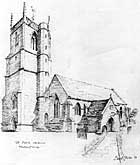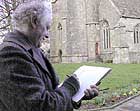

- [St Mary the Virgin]
- malting
- pubs
- mummers
- Tom Robinson
- general photographs
![]()
St Mary the Virgin
 |
the Parish Church of St Mary the Virgin, as drawn by David Fisher |
 |
David Fisher at work in the churchyard |
the Parish Church of St Mary the Virgin: a chronology
Information for this chronology was taken from H W Hayes and J E Walter, The Parish Church of St Mary the Virgin, Marshfield: A short history and guide, 1992.
1086
Domesday Book lists hide of land in Marshfield owned by priest,
indicating presence of church.
11th C
William the Conqueror gives manor of Marshfield to bishopric of
Wells.
1106
Manor passes to Bath Abbey.
1125
In deed, Simon, Bishop of Worcester, confirms that Robert Fitz-Hamon
has granted tithes, ecclesiastical benefices and churches -- among
them, the one at Marshfield, dedicated to St Nicholas -- to Tewkesbury
Abbey.
1170
Manor becomes property of Keynsham Abbey.
1228
Annals of Tewkesbury Abbey: 'On hearing of the death of the parson
at Marshfield, we, the Abbot of Tewkesbury, set out for the place;
and without opposition at the time, took possession on March 21st,
the second Sunday in Lent. Afterwards, however, we endured much
trouble at the hands of the Bishop of Worcester, William of Blois,
because he desired to call in question the aforesaid right.'
1229
Annals of Tewkesbury Abbey: 'The Bishop of Worcester, on the 8th
of May, held a synod at Worcester, and there withdrew the interdict
pronounced against the church at Mersfeld, at the request of Berard,
vicar of that church, through his proctor, the Abbot.'
1242
Annals of Tewkesbury Abbey: on 1 June, Walter de Cantelupe, Bishop
of Worcester, dedicates newly built church at Marshfield, on site
of present church.
c. 1470
Monks of Tewkesbury Abbey rebuild church in Perpendicular style:
raise roof and insert clerestory windows, lengthen chancel and
replace central tower with present western one. Church now dedicated
to St Mary the Virgin.
1523-38
Vicarage house built by vicar Thomas Parker. According to New
College, Oxford archives (1538), entire property comprises: 'First
a Fair House with a Stable and a Barn, one Garden & a little Orchard
containing by Estimation half an Acre of Ground in ye Hands of
ye Vicar. Item one little Garden in ye Occupation of Thos Crispe.
Item One Close of Pasture lying at Oldfield Gate commonly said
to be mowed containing by Estimation 3 acres or thereabouts. Item
five Acres of arable Land lying in a Field called Oldfield on
ye West Side of Jn Chambers ten Acres. Item one Acre in ye South
Field on ye South Side of a Green Meer. Yt is between west Marshfield
and ye Windmill in Cold Ashton Parish. Item one other Acre at
ye West End of ye Furlong shooting Westward of ye Innocke. Item
6 Acres and a half of Arable Land or thereabouts lying in ye North
Field aforesaid. Item there are Commons belonging to ye said Vicarage
according to ye Rates as other Men at Marshfield have.'
1529
Thomas Parker, chancellor to the bishop of Worcester, establishes
guild at church at request of John Gosslet, bailiff, and other
inhabitants.
1530s
At Dissolution, manor passes into private hands. Gift of benefice
of church with rectorial tithe conferred by Mary I on warden and
fellows of New College, Oxford, in lieu of property taken from
them by Henry VIII.
1540-6
Leland visits Marshfield some time during this period. Later,
he writes in his Itinery: 'There was as it is sayde a Nunnery at Marschefelde.'
1541
Jurisdiction of church passes to bishop of Gloucester.
1548
Edward VI's commissioners report two chantries in the 'P'ishe
of Marsefild where are houseling people D [i.e. 500]'. St Clement's
Service was founded by the parishioners for 'prayeng for the ffounders
sowlez and all Xtian sowlez'. Jh'us Service was founded by John
Doding for the same purpose.
1558
Marshfield's parish register is begun, at first only recording
baptisms. Burials are first entered in 1567 and marriages in 1572.
1645
According to the Proceedings of the Committee for Plundered Ministers
(3 December), 'Jn Oglander [vicar from 1642] deserted the cure
of his said Church when the Citty of Bath was last taken by the
Parliament forces and hath ever since absented himself. It is
therefore ordered that he make his personal appearance before
the Committee on the first day of January ensuing to answer to
all matters as shall be obtained against him before this Committee
and this Committee doe hereby authorise Arthur Bremble [Bramley]
a Godly and orthydox Divine to officiate the cure of the said
Church the mean tyme.' A later notice of the Committee says: '[Oglander]
deserted the cure and his Church there and betaken himselfe to
the forces raysed against the Parliament.'
1706
Marshfield Company of Bellringers founded, with set of articles
drawn up between Thomas Crisp and bellringers, which provides
fines for, among other things, any ringer who uses unseemly speech
or swears unseemly oaths or who commits a 'beastly abuse' in church
or ringing chamber.
1720
3rd bell in tower is cast by Rudhall's of Gloucester.
c. 1734
Vicar John Carey pulls down vicarage house and builds more commodious
replacement on same site. It comprises: '1 Faire parlour wainscotted
round about; 1 Little buttery, 1 hall, 1 great buttery; 1 Little
chamber, 1 kitchen with a loft over all the house; 1 Gate house
with stable, a barn and a garden, and little orchard containing
1/2 acre.'
1807
Bellringers have to reaffirm articles and promise not to ring
wholly for drink (a free barrel of beer is provided in tower to
be consumed during and after ringing) or to give visitors or cronies
more than two glasses of beer.
1818
New gallery erected near Singing Gallery at west end of church:
'There being a deficiency of Pews and Seats in Marshfield Church
for the accommodation of the Tenants of Sir C B Codrington, Bart,
a New Gallery was erected by the Steward by Sir Bethell's orders
and divided into 7 Pews or Seats and numbered as follows, viz.
No. 1. Allotted to Castle Farm
No. 2. Allotted to Oldfield Farm
No. 3. Allotted to Down Thorns Farm
No. 4. Allotted to King's Arms Inn
The three others were appropriated to three Freeholders named Daniel Wait, Stephen Yeeles and Wm Taylor. The whole expense [sic] of Erecting the said Gallery is as per bills £162-1-7.'
1819
On 24 May, Gloucester Journal reports: 'On the night of the 10th. instant the parish church
of Marshfield in this county was sacrilegiously entered, with
the evident design of stealing the Communion Plate; but as the
church-wardens prudently kept those valuable articles under their
own custody, the principal object of the villains was frustrated,
though they succeeded in forcing three strong locks and injuring
the church, and pilfering a few prayer books.'
1824
When improper language is used in ringing room by persons of bad
character, bellringers' rules are further tightened.
1826
Existence of church band to lead singing shown by entry in churchwardens'
accounts: 'To cash paid Mr Packer for New Violoncello £5-5-0 and
for a New Clarinett £2-2-0.' Accounts also record cash payment
to Thomas Davis of £16-14-2 1/2 for 'Gilt Weathercock and iron
work for that and the clock'.
1836
Church becomes part of combined diocese of Gloucester and Bristol.
1841
According to tithe award, New College holds 114 acres of rectorial
glebe, widely distributed throughout parish. The acreage of the
vicarial glebe held by Rev George Sherer corresponds closely to
that of 1538 (see above).
1844
Churchwardens pay 'James Long for keeping order in the Gallery
5s 0d.'
c. 1870
According to letter in Gloucestershire County Record Office, a
person 'when churchwarden quarrelled with Mr Bedford [vicar 1858-81],
and in spite burnt a lot of documents belonging to the Church
and went to Chapel.'
1860s
Drastic restoration of church during incumbency of Rev Bedford.
Over 80 memorial tablets are removed.
1860
Most of land held by New College, Oxford sold off at auction at
The Catherine Wheel by Marshfield auctioneer Henry Allen on 8 August.
1876
Font cover given in memory of James Strachan Clarke.
pre-1881
Sibyl Trotman writes: 'By the time we [Edward Fiennes Trotman
(vicar 1881-1910) and family] came, the choir of girls and small
organ had been moved from the gallery, where their conduct had
been a scandal. Every sort of missile, I have been told, was thrown
at the congregation below.'
1887
Work begun under Canon Trotman to celebrate Queen Victoria's Golden
Jubilee: renovation of inside and outside of tower; restoration
of porch (small Gothic niche revealed with traces of medieval
colour); provision of oak choir stalls, side screens and panelling
in chancel; removal of organ from gallery; repaving of chancel
floor. Work finished in 1902-3.
1889
Bells rehung on proper frame and chiming apparatus extended to
its present position in choir vestry.
1895
Organ, previously used in Worcester Cathedral while their organ
was being rebuilt, is brought to church, at cost of £200.
1897
In July, celebrations for Queen Victoria's Diamond Jubilee end
with church choir singing national anthem from top of church tower.
When combined diocese of Gloucester and Bristol splits, church comes under bishop of Bristol, following passage of Supplementary Act through both Houses of Parliament.
Bishop of Bristol comes to Marshfield to administer confirmation to 60 persons, the day after his enthronement at Bristol Cathedral (28 October).
1900
Prayer book rest on communion table given by Jessie Rawgill in
memory of Frances Mary Davis.
1903
Reredos in chancel, with carved figures of four evangelists, given
by Mr and Mrs C H Bromley Firth of Ashwicke Hall.
1901
At death of Canon Trotman, two smallest bells in tower are purchased
from Mears & Stainbanks of Whitechapel, making the peal up to
eight.
1917
Weight of eight bells puts such a strain on bell frame that it
has to be replaced.
1925
In January, Marshfield bellringers succeed (against competition
from a team from Bristol) in ringing 5,040 'changes' on eight
bells for the first time.
1932
The churchyard becoming full, all further burials (except in existing
family tombs) now take place in cemetery on Tormarton Road.
1940
November: windows in the north-west corner of the church are damaged
by bomb blast.
1950
Former chantry of St Clement at east end of north aisle is restored
to original design by Major John Pope in memory of his parents
Major and Mrs Maurice Pope of Ashwicke Hall.
1951
Members of St Mary's Guild donate stone steps of font.
1953
In November, church is united with Holy Trinity, Cold Ashton.
1976
Figure of Virgin and Child by Simon Verity, funded by various
gifts, inserted into niche in porch.
1979
Floor repaved with Purbeck stone. Beneath is placed a lead box
constructed by Mr J Walter, containing documents and small artefacts
representative of the time.
1982
When Rev John Prior leaves Marshfield, vicarage is sold and smaller
replacement erected in Church Lane.
1983
Gift of benefice of church is joined with that of Tormarton. Appointment
is now made alternately by New College, Oxford and bishop of Bristol.
1989
Outer doors removed, repaired and rebuilt in memory of Reginald
and Leslie Hayes, formerly of Manor House.
Back to history